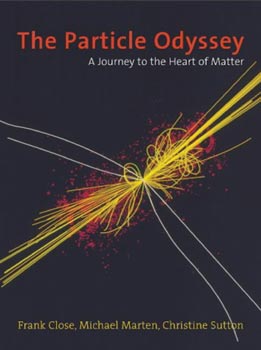by Frank Close, Michael Marten and Christine Sutton, Oxford University Press (2002), ISBN 0198504861, £29.95 (€48).
Fifteen years ago saw the publication of the most visually stunning, most accessible popular picture book on high-energy physics, The Particle Explosion. It resulted from a collaboration between theoretical physicist Frank Close, physicist and journalist Christine Sutton, and founder of the Science Photo Library Michael Marten. Theirs has proved a perfect partnership, bringing together clear explanation and story-telling; scientific rigour and journalistic flair; and visual impact.

The Particle Odyssey is not simply the same book under a new name. Some 250 of the pictures are entirely new, as are great swathes of text. Clearly, a lot has happened in the past 15 years, not least the complete operational lifetime of LEP, the discovery of the top quark at Fermilab, and the first signs of neutrino oscillations. It is also interesting to note how book design has changed. After leafing through Odyssey, Explosion seems strangely dated. The new edition has whiter, glossier paper and crisper illustrations, some of them bled off the pages. Every page is eye-catching, and I suspect that considerably more text has been squeezed into the same 240 pages, mostly by greater column width.
It is not easy to find a news peg in an incremental advance
Martin Redfern
The change of title is perhaps revealing too. Back in the 1980s, just after the discovery of the W and Z bosons, it seemed that there had been an explosion of particles, almost more than theory could accommodate. Since then, I suspect, to those patiently wading through the terabytes of data, it has been more like an odyssey to try and catch the last remaining particles within experimental range. It has been interesting to watch high-energy physics as a journalist for the past 15 years. It is not easy to find a news peg in an incremental advance. A few thousand more data points do not make a story; a surprise or a race between laboratories does. As a result, I think I reported the discovery of the top quark three or possibly four times before its final confirmation! On the other hand, it is frustrating when a laboratory won’t issue a public announcement even when you know the data are accumulating. This book recounts most of the trials and tribulations from the physicists’ point of view, and, by telling many of the stories in their historical sequence, it gives us some very readable tales.
I recommend this book to everyone, whether they have read The Particle Explosion already or not; and whether they are complete novices or professional physicists. If you don’t know the stories, it’s a new adventure. If you do, it’s a model of story-telling. And whoever said picture books were only for children? My only hope is that there will be enough new physics for another version in 15 years’ time.








